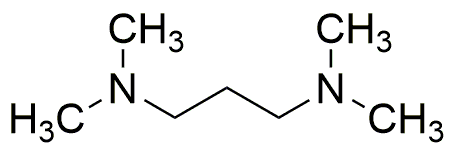N,N,N',N'-Tetramethyl-1,3-diaminopropane is widely utilized in research focused on:
- Polymer Production: This compound serves as a curing agent in the production of epoxy resins, enhancing the mechanical properties and thermal stability of the final products. It's particularly valuable in the automotive and aerospace industries where durable materials are essential.
- Chemical Synthesis: It acts as a versatile building block in organic synthesis, allowing researchers to create complex molecules. This is especially useful in pharmaceuticals, where it can help develop new drugs with specific therapeutic effects.
- Analytical Chemistry: The compound is used in chromatographic techniques to separate and analyze various substances, making it a critical tool in laboratories for quality control and research purposes.
- Corrosion Inhibitors: It is effective in formulating corrosion inhibitors for metals, providing protection in industrial applications, particularly in oil and gas pipelines, where preventing rust and degradation is crucial.
- Biochemical Applications: The compound has potential uses in biochemistry for modifying proteins and peptides, which can lead to advancements in drug delivery systems and targeted therapies.
General Information
Properties
Safety and Regulations
Applications
N,N,N',N'-Tetramethyl-1,3-diaminopropane is widely utilized in research focused on:
- Polymer Production: This compound serves as a curing agent in the production of epoxy resins, enhancing the mechanical properties and thermal stability of the final products. It's particularly valuable in the automotive and aerospace industries where durable materials are essential.
- Chemical Synthesis: It acts as a versatile building block in organic synthesis, allowing researchers to create complex molecules. This is especially useful in pharmaceuticals, where it can help develop new drugs with specific therapeutic effects.
- Analytical Chemistry: The compound is used in chromatographic techniques to separate and analyze various substances, making it a critical tool in laboratories for quality control and research purposes.
- Corrosion Inhibitors: It is effective in formulating corrosion inhibitors for metals, providing protection in industrial applications, particularly in oil and gas pipelines, where preventing rust and degradation is crucial.
- Biochemical Applications: The compound has potential uses in biochemistry for modifying proteins and peptides, which can lead to advancements in drug delivery systems and targeted therapies.
Documents
Safety Data Sheets (SDS)
The SDS provides comprehensive safety information on handling, storage, and disposal of the product.
Product Specification (PS)
The PS provides a comprehensive breakdown of the product’s properties, including chemical composition, physical state, purity, and storage requirements. It also details acceptable quality ranges and the product's intended applications.
Certificates of Analysis (COA)
Search for Certificates of Analysis (COA) by entering the products Lot Number. Lot and Batch Numbers can be found on a product’s label following the words ‘Lot’ or ‘Batch’.
*Catalog Number
*Lot Number
Certificates Of Origin (COO)
This COO confirms the country where the product was manufactured, and also details the materials and components used in it and whether it is derived from natural, synthetic, or other specific sources. This certificate may be required for customs, trade, and regulatory compliance.
*Catalog Number
*Lot Number
Safety Data Sheets (SDS)
The SDS provides comprehensive safety information on handling, storage, and disposal of the product.
DownloadProduct Specification (PS)
The PS provides a comprehensive breakdown of the product’s properties, including chemical composition, physical state, purity, and storage requirements. It also details acceptable quality ranges and the product's intended applications.
DownloadCertificates of Analysis (COA)
Search for Certificates of Analysis (COA) by entering the products Lot Number. Lot and Batch Numbers can be found on a product’s label following the words ‘Lot’ or ‘Batch’.
*Catalog Number
*Lot Number
Certificates Of Origin (COO)
This COO confirms the country where the product was manufactured, and also details the materials and components used in it and whether it is derived from natural, synthetic, or other specific sources. This certificate may be required for customs, trade, and regulatory compliance.

